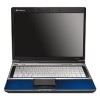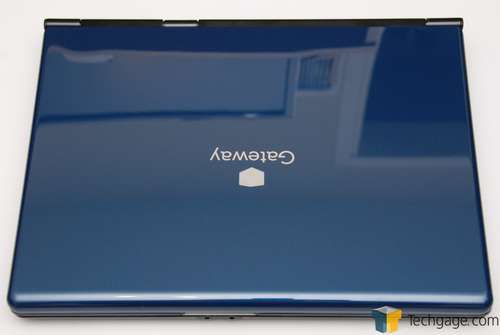- Qualcomm Launches Snapdragon 4 Gen 2 Mobile Platform
- AMD Launches Ryzen PRO 7000 Series Mobile & Desktop Platform
- Intel Launches Sleek Single-Slot Arc Pro A60 Workstation Graphics Card
- NVIDIA Announces Latest Ada Lovelace Additions: GeForce RTX 4060 Ti & RTX 4060
- Maxon Redshift With AMD Radeon GPU Rendering Support Now Available
Gateway T-6836 14.1″ Notebook

Notebooks are more popular than ever, and the vast selection is incredible. There’s a notebook for everyone, and in the case of Gateway’s T-6836, if you are looking for something in between a netbook and a $1,000 model – you are covered. It carries certain downsides, but still packs enough performance and features to make the $800 retail price feel well-worth it.
Page 1 – Introduction
It’s been quite a while since we last took a look at a notebook that didn’t have an ASUS badge on it, and that’s not for good reason. ASUS keeps sending us notebooks, so we keep reviewing ’em, but going forward, we are starting to evaluate other company’s offerings as well, beginning with this Gateway. We’ll also be taking a look at others in the months to come, so stay tuned.
Gateway offers a wide-range of notebooks to fit all budgets, from the MT series, which begins out at $649, to the P series which scales up to $1,999. Unlike some other notebook vendors, Gateway doesn’t allow configuration of their machines prior to a purchase, but they make up for it by offering a large variety of different notebooks under each series.
The company also recently dropped online sales in lieu of selling through their selected partners, which results in certain models only being available with select stores. This is an obvious downside, but luckily, all of the notebooks can be ordered online via the respective store’s website.
I had to take this route earlier this year when I purchased their XHD3000 monitor. This also led me to experience their customer service, which I can admit was rather good. The model I received at first was faulty, but within two weeks of getting the order in, I received a brand-new monitor, then was able to send the faulty model back. Being in Canada, I found the quick replacement to be impressive. It’s likely to be even quicker if you live in the USA.
Closer Look at Gateway’s T-6863
The model we’re looking at here is the T-6836. Gateway’s T-series is one that targets the mobile multimedia hound on a budget, and given its $799 price tag, it should appeal to a wide audience. The notebook features Intel’s 65nm T5750 Core 2 Duo at 2.00GHz (2MB L2, 667MHz FSB), 4GB of DDR2-667 memory, a 250GB 5400RPM hard drive, 8x DVD-RW with LabelFlash and Intel’s X3100 integrated graphics solution.
At the $799 price point, we can already get an idea of what to expect from this notebook. It’s not going to deliver performance that power-hungry users are going to be looking for, but rather is designed for those who want a solid notebook at a great price. Given that netbooks nowadays don’t cost much less than this, it makes a model like this look even more attractive.
Apologies in advance for some of the bad color in the photographs here. I didn’t notice the lighting was so bad while they were being taken. The T-6836 features a glossy ‘pacific blue’ finish that is simple, but clean. The hood is etched with Gateway’s logo in the direct center, and will never peel off as it’s actually part of the cover.
The notebook features a full-sized keyboard, brushed-metal finish around the trim, cleanly-implemented buttons along the top and a pure-black finish around the display. A 1.3megapixel webcam is also included, along with a small microphone.
In front of the touchpad are the audio jacks, one for a mic, the other for speakers/headphones. On the left side you can find the memory card slot and also the wireless enable/disable. The right-side of the notebook doesn’t feature anything except the ROM drive.
Above the keyboard is a slew of buttons, including the power, media control and the volume. The two-channel sound is taken care of by a speaker on each side of this top portion.
If you’ve read my notebook reviews in the past, you probably know that I’m a bit fussy when it comes to the touchpad. It’s rare when I find one that I truly like, and this one is no different. It works, but I didn’t find it to be that enjoyable to use for any amount of time.
It’s easy on the fingers, but the buttons aren’t placed in such a way that they’re easily pushed whenever you need them. I found my thumb had to strain more than it should have. Your experience may vary.
In the pictures below, please ignore the rough top of the notebook, as I took these pictures out-of-order. The rough top is the protective plastic.
On the left side of the notebook, we find the wired network port, two USB, the main air vent, an Express Card slot, memory card slot and also the WiFi enable/disable.
There is not too much to be found on the right-side, except the DVD-RW drive and another USB port. There are three USB ports in total, which I’m sure many will appreciate.
Like the right-side, there is not much to see on the back except a modem port, Kensington lock, VGA output and the power port.
Underneath the notebook we can see all the various air vents and removable panels. The panel on the bottom left-hand side can be removed to replace the hard drive and Mini-PCI card (which is where the wireless is), while the much larger panel can be “removed” to swap out the RAM.
I say “removed”, because with the lone screw removed, there was something else holding on, which could have been glue – so leaving it alone is a good idea. There’s little worry in that, however, as there’s already 4GB of RAM installed, which means there’s virtually no reason to upgrade even further, especially on a lower-end model.
Included with the notebook are quick-setup guides, the battery, power adapter and Windows Vista Home Premium CD. There are virtually no extras found here, but that’s to be expected of a budget notebook.
With our exhaustive tour out of the way, let’s jump into my thoughts on the setup.
Support our efforts! With ad revenue at an all-time low for written websites, we're relying more than ever on reader support to help us continue putting so much effort into this type of content. You can support us by becoming a Patron, or by using our Amazon shopping affiliate links listed through our articles. Thanks for your support!

















